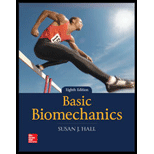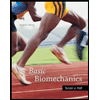
Concept explainers
INTRODUCTORY PROBLEMS
1. What regions of the spine contribute the most to flexion? Hyperextension? Lateral flexion? Rotation?
To explain: The regions of the spine that contribute to most of the flexion.
Concept introduction: The trunk or torso region is the central part of the body that includes, chest, bask, and abdomen. The trunk movement includes the movement of the lumbar and dorsal regions of the spine. The two movements that affect the angle between the parts of the body are called the flexion and extension.
Explanation of Solution
The range of motion at the motion segments are governed by the anatomical constraints. This will be varying in different regions of the spine. The various regions of the spine are given as follows:
- Cervical region
- Thoracic region
- Lumbar region
Flexion of the spine is more important in the regions of the spine. Flexion occurs in the cervical and lumbar regions of the spine. This mainly occurs in the facet joints. In cervical region, atlanto-occipital joint permits the flexion. This determines the movement capabilities of the motion segment. Hip flexion occurs in the sagittal plane rotation of the femur with respect to the pelvic girdle.
To explain: The regions of the spine contribute to most of the extension.
Concept introduction: The trunk or torso region is the central part of the body that includes, chest, bask, and abdomen. The trunk movement includes the movement of the lumbar and dorsal regions of the spine. The two movements that affect the angle between the parts of the body are called the flexion and extension.
Explanation of Solution
The range of motion at motion segments are governed by the anatomical constraints. This will be varying in different regions of the spine. The various regions of the spine are given as follows:
- Cervical region
- Thoracic region
- Lumbar region
Extension occurs in the cervical and lumbar regions of the spine. When the trunk is flexed in the lumbar spine, the anterior pelvic tilt causes an additional motion called the extension. The backward extension of spine in the anatomical position is called the hyperextension.
To explain: The regions of the spine contribute to most of the lateral flexion.
Concept introduction: The trunk or torso region is the central part of the body that includes, chest, bask, and abdomen. The trunk movement includes the movement of the lumbar and dorsal regions of the spine. The two movements that affect the angle between the parts of the body are called the flexion and extension.
Explanation of Solution
The range of motion at motion segments are governed by the anatomical constraints. This will be varying in different regions of the spine. The various regions of the spine are given as follows:
- Cervical region
- Thoracic region
- Lumbar region
Lateral flexion occurs when the frontal plane movement of the spine is away from the anatomical position. Lateral flexion occurs in the cervical, thoracic, and lumbar regions of spine. The movement lateral flexion is high in the cervical region that allows approximately 9-10º of motion at C4-C5.
To explain: The regions of the spine contribute to most of the rotation.
Concept introduction: The trunk or torso region is the central part of the body that includes, chest, bask, and abdomen. The trunk movement includes the movement of the lumbar and dorsal regions of the spine. The two movements that affect the angle between the parts of the body are called the flexion and extension.
Explanation of Solution
The range of motion at motion segments are governed by the anatomical constraints. This will be varying in different regions of the spine. The various regions of the spine are given as follows:
- Cervical region
- Thoracic region
- Lumbar region
A rotation occurs in the transverse plane of the spine. This allows 12º of motion at C1-C2. The rotation also occurs in the thoracic and lumbar regions of the spine. The rotation occurs in the lumbar region due to the interlocking of the articular process in the vertebral column. The rotation also occurs in the lumbosacral joint at a lesser rate. The coupling of the structures in the vertebral column causes the rotation movement along with a slight lateral flexion on the same side.
Want to see more full solutions like this?
Chapter 9 Solutions
BASIC BIOMECHANICS
- Give the correct instructions on how to perform the following skills under locomotor & non locomotor movements. Locomotor 1.crawl 2.creep 3.jump 4.walk 5.lunge turn 6.squat turn Non locomotor 1.Standing position 2.Sitting pos. 3.Kneeling pos. 4.Lying pos. 5.Arm support pos. 6.Four base pos. 7.Hand pos. 8.Arms pos.arrow_forwardName 4 exercises that include VARIOUS DIRECTIONAL LOCOMOTOR & BALLISTIC MOVEMENTS, 3 PLANES OF MOVEMENTS.arrow_forward5 of 10 Which of the following exercises would be an example of a Stabilization-Focused exercise for the shoulders? Standing cable row Bench press Single-leg dumbell overhead press shoulder press machine Next ▶arrow_forward
- 5 Describe the difference in maximal force capacity in the knee extensors vs the knee flexors. What role does bi-articulation at this joint play? How does this influence potential injury mechanics?arrow_forwardWhat is the primary factor when loading upper body exercises? Posture The type of grip The force vector The position of the scapulaearrow_forwardGIVE 3 EXERCISE THAT CAN BE CONSIDERED AS A LOCOMOTOR MOVEMENT WITH FLEXION AND EXTENSION MOVEMENT (mixed, not separated)I NEED IT ASAParrow_forward
- Which of these increases force production? 1. Increasing the velocity of the concentric contraction 2. Increasing the velocity of the eccentric contraction 3. Increasing strength of neural stimulation 4. Holding your breath during contraction 5. Increasing frequency of neural stimulation 6. Decreasing the velocity of the concentric contraction 7. Starting the contraction with the joint in full extension 8. Decreasing the velocity of the eccentric contractionarrow_forward1) What do you understand by a process of Optimization in Biomechanics with respect to the determination of muscular forces in a system that is in equilibrium?2) What do you understand by synovial joints and how are they related to musculoskeletal problems associated with aging?3) What do you understand by the concept of range of motion (ROM) in joint biomechanics and what are the factors that determine its range of function?4) How is the skeletal system related to other systems/organs? Give 3 examples.arrow_forwardBefore testing a true 1-RM exercise, why should you allow your client to complete 3 trial repetitions first? Select 2 correct answer(s) To reduce risk of injury To ensure form is correct To fatigue the muscles to a "normal" functional strength To focus on the eccentric and concentric portions of the movementarrow_forward
- Exercise 2: Axial and Appendicular Skeleton The following diagram of the human skeleton has 3 bones colored in (orange) and labeled A-C. Match the following bones with whether they are part of the axial or appendicular skeleton. A B C A Axial B Axial Appendiculararrow_forwardDiscuss how the following exercises can help the body and explain how to execute each exercises 1. Long arm crunches 2. High Stepping 3. Skipping without ropearrow_forward5 Exercise 3: Directional Terminology (Q004) Which of the following bones IS NOT DISTAL to the femur? O Tibia O Sacrum O Tarsals O Metatarsals O Fibulaarrow_forward

 Basic BiomechanicsBioengineeringISBN:9780073522760Author:Susan J HallPublisher:McGraw-Hill Education
Basic BiomechanicsBioengineeringISBN:9780073522760Author:Susan J HallPublisher:McGraw-Hill Education

